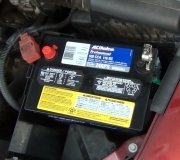If I might add a few comments of value, your car did not drain your friend's battery in two minutes. You'd have serious smoke and melted wires for it to happen that quickly. A good, fully-charged battery can easily run a starter motor sporadically totaling well over two minutes, and they draw around 150 amps. To put that in perspective, a pair of normal head light bulbs draw around ten amps. To kill a good battery in two minutes, it's tongue would be hanging out and sweat would be pouring from it. Something else is going on. A good suspect is the two battery cables. On a lot of Ford products, corrosion occurs on the first inch of either end of either cable, under the insulation where you can't see it. You may wiggle a cable, then everything works, and that makes you think the connections need to be cleaned. Cleaning won't help, but removing them disturbs the corroded wire ends enough that they might work okay for a week or two, making you think that was the solution.
One thing that jumped out was when you said you used the jumper cables to charge your battery for ten minutes. That's not long enough. A good, fully-charged battery will measure 12.6 volts. A totally discharged battery will measure close to 12.2 volts. At that point it's not strong enough to do reasonable work, but it will start to recharge right away. When you have less than ten volts, as you did, it will take a minimum of 15 minutes on a charger or jumper cables for the acid in the battery to become conductive, THEN it will start to charge. If you watch the "Amps" gauge on a portable charger, you'll see it stay on "0", then by 15 - 20 minutes the gauge will go up, indicating current is flowing through the battery to charge it. After about two hours on a slow rate, current will come back down. You can consider the battery fully charged when current drops to five amps.
Reading about reversed battery cables made the hair on the back of my neck stand up. Bad cables or a dead battery may have saved you from serious damage. Your car has dozens of computer modules in it, and they will be damaged from reverse polarity. All of them have diodes built in for protection. A diode is a one-way valve for electrical current flow. They are placed backward in the computers between their ground and 12-volt feed terminals. Being backward, they do nothing at all. It's like they aren't even there. When the battery cables are reversed, those diodes become "forward biased", meaning they turn on and act exactly like a piece of wire. That causes very high current to flow which blows the fuses for those circuits, thereby protecting the modules. Most of the time you only need to correct the cables, then replace the blown fuses. If the battery was nice and strong, expect to find a dozen or more blown fuses. There will be, at a minimum, a fuse box under the hood and one inside the car.
The generator also has six diodes for a different purpose, but when the engine is not running, those diodes are all that stands in the way of the battery discharging instantly through the alternator. Years ago there was a special short section of fuse link wire spliced into the generator's output wire to protect for reversed cables, but almost all vehicles now use a very large fuse that's bolted into the under-hood fuse box. On most cars other than GM products, that fuse doesn't feed anything else, so if it's blown, the only symptom is the charging system won't keep the battery charged. At most, with no lights or heater fan turned on, you'll be able to drive no more than an hour before the battery runs dead. You should be able to visually inspect that fuse, but for most models, if it's blown, the engine will still start and run.
Happy Sunday to you CJ, and Merry Christmas!
Sunday, December 17th, 2017 AT 2:15 AM


